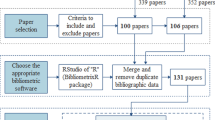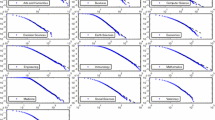Abstract
A mathematical treatment is given for the family of scientometric laws (usually referred to as the Zipf-Pareto law) that have been described byPrice and do not conform with the usual “Gaussian” view of empirical distributions. An analysis of the Zipf-Pareto law in relationship with stable non Gaussian distributions. An analysis of the Zipf-Pareto law in relationship with stable non Gaussian distributions reveals, in particular, that the truncated Cauchy distribution asymptotically coincides with Lotka's law, the most well-known frequency form of the Zipf-Pareto law. The mathematical theory of stable non Gaussian distributions, as applied to the analysis of the Zipf-Pareto law, leads to several conclusions on the mechanism of their genesis, the specific methods of processing empirical data, etc. The use of non-Gaussian processes in scientometric models suggests that this approach may result in a general mathematical theory describing the distribution of science related variables.
Similar content being viewed by others
Notes and references
D. DE SOLLA PRICE, A general theory of bibliometric and other cumulative advantage processes,Journal of American Society for Information Science, 27 (1976), No. 5, p. 292.
V. M. PETROV, A. I. YABLONSKY,Matematika i sotsialnye protsessy (giperbolicheskie raspredeleniya i ikh primenenie) (Mathematics and Social Processes (Hyperbolic Distributions and their Application)), Moscow, Moscow, 1980.
D. DE SOLLA PRICE,Little Science, Big Science, Columbia Univ. Press, 1963.
P. D. ALLISON, D. DE S. PRICE, B. C. GRIFFITH, M. J. MORAVCSIK, J. A. STEWART, Lotka's Law: a Problem in its Interpretation and Application,Social Studies of Science, 6 (1976) No. 2, p. 269–276.
A. I. YABLONSKY, On Fundamental Regularities of the Distribution of Scientific Productivity,Scientometrics, 2 (1980) No. 1, p. 3–34.
A. I. YABLONSKY,Modeli i metody matematicheskogo issledovaniya nauki (nauchno-analiticheski obzor), Models and methods of mathematical science of science (a scientific analytical survey), Moscow, 1977.
A. I. YABLONSKY, Stokhasticheskie modeli nauchnoi deyatel'nosti. Sistemnye issledovaniya,Yezhegodnik-1975, (Stochastic models of scientific activity. In:Systems research, Yearbook 1975, Moscow, 1975). The author is indebted to S. D. HAITUN for presenting and propagating in his surveys, in particular, “Naukometriya-sostoyanie i perspektivy (Scientometrics: status and outlook) Moscow, 1983”, the concepts expressed by A. I. YABLONSKY, as a “non-Gaussian approach to scientometrics with the aid of stable non-Gaussian distributions”7 (further developed in this paper). Unfortunately, in his presentation of our concept S. D. HAITUN made some errors. For instance, in the above survey he wrote: “Gaussian non-Zipf distributions (Gaussian, Poisson, etc.) have α=2" (p. 189). This is not true because in the Gaussian distribution α=2 and in the Poisson distribution α is not present as a characteristic index. He went on saying that “distributions of the non-Gaussian totality of stationary distributions of human entropy have a higher entropy than distribution of a Gaussian totality of stationary natural distributions” (p. 189). This is not true in general, because the entropy of any distribution can, depending on the associated parameters, take on a fairly wide range of values (in particular, for the Gaussian distribution the entropy is controlled by the variance). HAITUN was also wrong in saying “Human society develops towards higher entropy” (p. 189). Development always tends to reduce the entropy which is a mesure of disorder and degradation. These examples illustrate the need of a more stringent and consistent approach to the very delicate subject of Gaussian processes.
M. Z. BOR, Nauka upravleniys i upravlenie nauchnymi issledovaniyami. V. kn.:Problemy upravleniya nauchnymi issledovaniyami (The Management Science and Research Management), in:Problems in Research Management) Moscow, 1973, p. 13.
A. YA. KHINCHIN,Predel'nye zakony dlia summ nezavisimykh sluchainykh velichin, (Limit Laws for Sums on Independent Random Values). Moscow — Leningrad, 1938.
J. STEINDL,Random Processes and the Growth of Firms, N.-Y., 1965.
N. CHOMSKY, G. A. MILLER, Finitary Models of Language Users,Handbook of Mathematical Psychology, Vol. 2 John Wiley & Sons, Inc., New York, 1963, pp. 419–491.
B. V. GNEDENKO, A. N. KOLMOGOROV.Predel'nye raspredeleniya dlia summ nezavisimykh sluchainykh velichin (Limit Distributions for Sums of Independent Random Values), Moscow — Leningrad, 1949.
J. LAMPERTI,Probability: a Survey of the Mathematical Theory, Dartmouth College, New York-Amsterdam, 1966, p. 75.
YU. V. PROKHOROV, YU. A. ROZANOV,Teoriya veroyatnosti (Theory of Probability) Moscow, 1967, p. 238.
H. H. GOODE, R. E. MACHOL,System Engineering: an Introduction to the Design of Large-scale Systems, Mc-Graw Hill Book Company, Inc., New York-Toronto-London, 1957, p. 111.
B. A. SEVASTIANOV,Vetviashchiesia protsessy, (Branching Processes). Moscow, 1971.
W. FELLER,A Introduction to Probability Theory and its Application Vol. I. Second edition. John Wiley and Sons, Inc., New York, Chapman & Hall, Ltd., London.
G. N. DOBROV,Nauka o nauke (Science of Science), Kiev, 1970, p. 170.
G. K. ZIPF,Human Behaviour and the Principle of Least Effort, Cambridge, 1949.
W. FELLER,An Introduction to Probability Theory and its Application. Vol. II. John Wiley & Sons, Inc., New York-London-Sydney, 1966.
O. LANGE,Vvedenie v ekonometriku (Introduction into Econometrics). Moscow, 1964.
Author information
Authors and Affiliations
Rights and permissions
About this article
Cite this article
Yablonsky, A.I. Stable non-Gaussian distributions in scientometrics. Scientometrics 7, 459–470 (1985). https://doi.org/10.1007/BF02017161
Received:
Issue Date:
DOI: https://doi.org/10.1007/BF02017161




